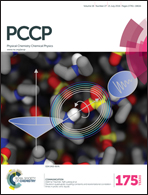Two-photon-absorption DNA sensitization via solvated electron production: unraveling photochemical pathways by molecular modeling and simulation†
Abstract
DNA photosensitization is one of the physical processes behind photodynamic therapy techniques, i.e. the combined use of photoactive drugs and visible radiation for therapeutical purposes. In this contribution we report the analysis of the photophysical properties of a two-photon absorption dye together with its interaction with DNA. The linear and non-linear optical properties are modeled taking into account the complex environment including dynamic and vibrational effects. It is also clearly demonstrated that the excited state manifold may evolve toward spontaneous photoionization with the production of a solvated electron. In turn both the radical cation and the solvated electron may react with the DNA backbone to produce a strand break; hence we have characterized a phototherapeutic dye that absorbs in the infrared region and is able to work under hypoxidic conditions, i.e. a prodrug of great interest for the potential treatment of solid tumors.


 Please wait while we load your content...
Please wait while we load your content...